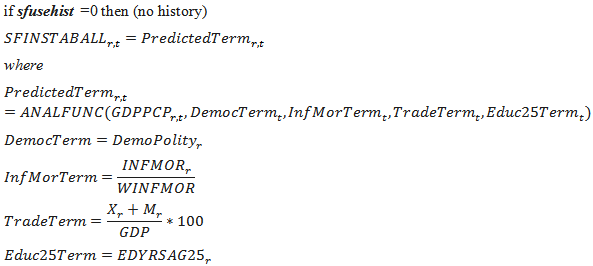International Futures Help System
Equations: Political Stability/Instability
The State Failure project has analyzed the propensity for different types of state failures within countries, including those associated with revolution, ethnic conflict, genocide-politicide, and abrupt regime change (using categories and data pioneered by Ted Robert Gurr. Upon the advice of Gurr, IFs groups the first three as internal war and the last as political instability. The model formulations for political instability are older and less well developed than those for internal war; we therefore recommend focus on internal war. Nonetheless, we document the approach to instability here.
The extensive database of the project includes many measures of failure. IFs has variables representing the probability of the first year or a continuing year of instability (SFINSTABALL) and the magnitude of a first year or continuing event (SFINSTABMAG).
Using data from the State Failure project, formulations were estimated for each variable using up to five independent variables that exist in the IFs model: democracy as measured on the Polity scale (DEMOCPOLITY), infant mortality (INFMOR) relative to the global average (WINFMOR), trade openness as indicated by exports (X) plus imports (M) as a percentage of GDP, GDP per capita at purchasing power parity (GDPPCP), and the average number of years of education of the population at least 25 years old (EDYRSAG25). The first three of these terms were used because of the state failure project findings of their importance and the last two were introduced because they were found to have very considerable predictive power with historic data.
The IFs project developed an analytic function capability for functions with multiple independent variables that allows the user to change the parameters of the function freely within the modeling system. The default values seldom draw upon more than 2-3 of the independent variables, because of the high correlation among many of them. Those interested in the empirical analysis should look to a project document (Hughes 2002) prepared for the CIA's Strategic Assessment Group (SAG), or to the model for the default values.
One additional formulation issue grows out of the fact that the initial values predicted for countries or regions by the six estimated equations are almost invariably somewhat different, and sometimes quite different than the empirical rate of failure. There may well be additional variables, some perhaps country-specific, that determine the empirical experience, and it is somewhat unfortunate to lose that information. Therefore the model computes three different forecasts of the six variables, depending on the user's specification of a state failure history use parameter (sfusehist). If the value is 0, forecasts are based on predictive equations only. The equation below illustrates the formulation. The analytic function obviously handles various formulations including linear and logarithmic.

If the value of the sfusehist parameter is 1, the historical values determine the initial level for forecasting, and the predictive functions are used to change that level over time. Again the equation is illustrative.

If the value of the sfusehist parameter is 2, the historical values determine the initial level for forecasting, the predictive functions are used to change the level over time, and the forecast values converge over time to the predictive ones, gradually eliminating the influence of the country-specific empirical base. That is, the second formulation above converges linearly towards the first over years specified by a parameter (polconv), using the CONVERGE function of IFs.

 International Futures at the Pardee Center
International Futures at the Pardee Center